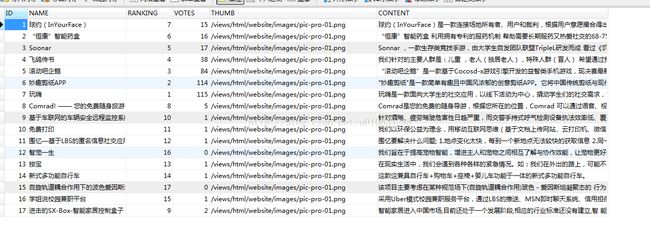spring4.0.9结合redis进行数据的缓存
一、今天将以前公司的由SpringMVC搭建的框架和redis整合。Spring版本为4.0.9 redis安装在linux(CentOS6.5)下面。数据库使用mysql。
由于redis,
1、优异的读写性能
我在这里使用了Redis-benchmark这个自带的性能测试工具进行了测试,由于是学习的机子,性能一般所以测试结果
测试命令: redis-benchmark -h 192.168.100.131 -p 6379 -c 100 -n 100000
100个并发连接,100000个请求,检测host为localhost 端口为6379的redis服务器性能
====== SET ======
100000 requests completed in 5.15 seconds
19432.57 requests per second
====== GET ======
100000 requests completed in 5.51 seconds
18162.01 requests per second
每秒钟可以set 或者get差不多2万条。
2 支持数据持久化,支持AOF和RDB两种持久化方式
3 支持主从复制,主机会自动将数据同步到从机,可以进行读写分离。
4 数据结构丰富:string(字符串)、list(链表)、set(集合)、zset(sorted set --有序集合)和hash(哈希类型)
该项目是一个作品投票的项目,是一个互联网项目的一个子项目,我们知道作品投票有个特点就是:作品这个表是经常被查询,数据基本不变,我们就没有必要每次用户进入页面的时候就进行数据库查询,我们只要在redis中直接读取就可以了,下面我通过这个项目进行spring和redis进行整合。
1、项目的POM.xml文件加入所需要的jar包
org.apache.commons
commons-pool2
2.4.2
redis.clients
jedis
2.8.0
org.springframework.data
spring-data-redis
1.6.6.RELEASE
2、为了便于redis配置的管理,我们把一些配置信息单独出来放入redis.properties
redis.hostName=192.168.100.131
redis.port=6379
redis.timeout=15000
redis.usePool=true
redis.maxIdle=6
redis.minEvictableIdleTimeMillis=300000
redis.numTestsPerEvictionRun=3
redis.timeBetweenEvictionRunsMillis=60000
4、在Spring配置文件中加入读取redis.properties 和redis-context.xml代码
classpath:/config/redis.properties
5、这里需要加入监听器,这个监听器的作用是我们启动项目的时候会把数据库中的数据(这些数据基本不变),放入redis中,下次们去拿的数据,可以直接总redis中获得,无需进入数据库中读取。
import java.util.HashMap;
import java.util.List;
import java.util.Map;
import org.apache.log4j.Logger;
import org.springframework.beans.factory.annotation.Autowired;
import org.springframework.context.ApplicationListener;
import org.springframework.context.event.ContextRefreshedEvent;
import org.springframework.stereotype.Service;
@Service
public class StartAddCacheListener implements ApplicationListener {
// 日志
private final Logger log = Logger.getLogger(StartAddCacheListener.class);
@Autowired
private RedisCacheUtil 6、将该监听器放入spring配置文件中
import java.util.ArrayList;
import java.util.HashSet;
import java.util.Iterator;
import java.util.List;
import java.util.Map;
import java.util.Set;
import org.springframework.beans.factory.annotation.Autowired;
import org.springframework.beans.factory.annotation.Qualifier;
import org.springframework.data.redis.core.BoundSetOperations;
import org.springframework.data.redis.core.HashOperations;
import org.springframework.data.redis.core.ListOperations;
import org.springframework.data.redis.core.RedisTemplate;
import org.springframework.data.redis.core.ValueOperations;
import org.springframework.stereotype.Service;
@Service
public class RedisCacheUtil {
@Autowired
@Qualifier("jedisTemplate")
public RedisTemplate redisTemplate;
/**
* 缓存基本的对象,Integer、String、实体类等
*
* @param key
* 缓存的键值
* @param value
* 缓存的值
* @return 缓存的对象
*/
public ValueOperations setCacheObject(String key, T value) {
ValueOperations operation = redisTemplate.opsForValue();
operation.set(key, value);
return operation;
}
/**
* 获得缓存的基本对象。
*
* @param key
* 缓存键值
* @param operation
* @return 缓存键值对应的数据
*/
public T getCacheObject(String key/* ,ValueOperations operation */) {
ValueOperations operation = redisTemplate.opsForValue();
return operation.get(key);
}
/**
* 缓存List数据
*
* @param key
* 缓存的键值
* @param dataList
* 待缓存的List数据
* @return 缓存的对象
*/
public ListOperations setCacheList(String key, List dataList) {
ListOperations listOperation = redisTemplate.opsForList();
if (null != dataList) {
int size = dataList.size();
for (int i = 0; i < size; i++) {
listOperation.rightPush(key, dataList.get(i));
}
}
return listOperation;
}
/**
* 获得缓存的list对象
*
* @param key
* 缓存的键值
* @return 缓存键值对应的数据
*/
public List getCacheList(String key) {
List dataList = new ArrayList();
ListOperations listOperation = redisTemplate.opsForList();
Long size = listOperation.size(key);
for (int i = 0; i < size; i++) {
dataList.add((T) listOperation.leftPop(key));
}
return dataList;
}
/**
* 缓存Set
*
* @param key
* 缓存键值
* @param dataSet
* 缓存的数据
* @return 缓存数据的对象
*/
public BoundSetOperations setCacheSet(String key, Set dataSet) {
BoundSetOperations setOperation = redisTemplate.boundSetOps(key);
/*
* T[] t = (T[]) dataSet.toArray(); setOperation.add(t);
*/
Iterator it = dataSet.iterator();
while (it.hasNext()) {
setOperation.add(it.next());
}
return setOperation;
}
/**
* 获得缓存的set
*
* @param key
* @param operation
* @return
*/
public Set getCacheSet(String key/*
* ,BoundSetOperations
* operation
*/) {
Set dataSet = new HashSet();
BoundSetOperations operation = redisTemplate.boundSetOps(key);
Long size = operation.size();
for (int i = 0; i < size; i++) {
dataSet.add(operation.pop());
}
return dataSet;
}
/**
* 缓存Map
*
* @param key
* @param dataMap
* @return
*/
public HashOperations setCacheMap(String key, Map dataMap) {
HashOperations hashOperations = redisTemplate.opsForHash();
if (null != dataMap) {
for (Map.Entry entry : dataMap.entrySet()) {
/*
* System.out.println("Key = " + entry.getKey() + ", Value = " +
* entry.getValue());
*/
hashOperations.put(key, entry.getKey(), entry.getValue());
}
}
return hashOperations;
}
/**
* 获得缓存的Map
*
* @param key
* @param hashOperation
* @return
*/
public Map getCacheMap(String key/*
* ,HashOperations hashOperation
*/) {
Map map = redisTemplate.opsForHash().entries(key);
/* Map map = hashOperation.entries(key); */
return map;
}
/**
* 缓存Map
*
* @param key
* @param dataMap
* @return
*/
public HashOperations setCacheIntegerMap(String key, Map dataMap) {
HashOperations hashOperations = redisTemplate.opsForHash();
if (null != dataMap) {
for (Map.Entry entry : dataMap.entrySet()) {
/*
* System.out.println("Key = " + entry.getKey() + ", Value = " +
* entry.getValue());
*/
hashOperations.put(key, entry.getKey(), entry.getValue());
}
}
return hashOperations;
}
/**
* 获得缓存的Map
*
* @param key
* @param hashOperation
* @return
*/
public Map getCacheIntegerMap(String key/*
* ,HashOperations<
* String,String,T>
* hashOperation
*/) {
Map map = redisTemplate.opsForHash().entries(key);
/* Map map = hashOperation.entries(key); */
return map;
}
}
8、测试类
import java.util.Map;
import javax.servlet.http.HttpServletRequest;
import javax.servlet.http.HttpServletResponse;
import org.springframework.beans.factory.annotation.Autowired;
import org.springframework.stereotype.Controller;
import org.springframework.web.bind.annotation.RequestMapping;
import org.springframework.web.servlet.ModelAndView;
@Controller("/RedisTest")
@RequestMapping({ "/RedisTest*" })
public class RedisTest {
@Autowired
private RedisCacheUtil下面我启动项目,日志提示将读取17条数据
9、上面提到,有个测试工具类,我们触发它,查看控制台打印数据
我这里数据库并不多,只有十几条,如果数量达到几百万上千万的时候,我每次重启项目都去查询数据库的一千万条记录,显然不合理,所以,对这个项目整合只是一个开始,后面我会尝试在表中加入大量数据,并且对数据进行持久化,如果有时间和机会会在项目尝试redis的主从复制以及读写分离等等。

